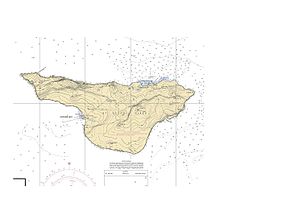St. George Island (Alaska)
| St. George Island | ||
|---|---|---|
| Cliff coast of St. George Island with rock gulls | ||
| Waters | Bering Sea | |
| Archipelago | Pribilof Islands | |
| Geographical location | 56 ° 36 ′ N , 169 ° 33 ′ W | |
|
|
||
| length | 18 km | |
| width | 8 kilometers | |
| surface | 90 km² | |
| Highest elevation | Ulakaia Hill 315.3 m |
|
| Residents | 108 (2014) 1.2 inhabitants / km² |
|
| main place | St. George | |
| Aerial view of the main town of St. George | ||
St. George Island is the second largest and southernmost of the four Pribilof Islands belonging to the US state of Alaska in the Bering Sea . The 18 km long and 90 km² large island is of volcanic origin and mainly made of basalt . St. George is around 60 km away from the largest island of St. Paul in the northwest of the archipelago.
St. George Island has 108 inhabitants (as of 2014), all of whom live in the capital of the same name, St. George .
history
The island of St. George was discovered in 1788 by the Russian navigator Gavriil Loginowitsch Pribylow in search of summer quarters and the place where the ear seals were raised. According to a story of the inhabitants of Unimak , the largest and easternmost island in the Aleutian Islands , an ancestral ship drifted away during a storm. By chance he discovered an island that was called "Amiq" by the residents of Unimak.
After hearing this story, Pribylov set sail in 1788 with his ship St. George and his crew, consisting of Russians and Aleutians , from the main Aleutian island, Unalaska . After a three-week odyssey he heard the roar of the ear seals and discovered a small uninhabited island. He named it after his ship “St. George".
After an extensive hunt for the seals, part of his crew remained on the island at his command. Pribylov returned to Unalaska with the furs. The men who stayed behind had the task of continuing to beat seals until they were picked up again in the summer. The food supplies quickly became scarce. For the time being, they ate seal meat and bird eggs . When they sighted an island in the north, they decided to go there on a self-made Baidarka . They gave the island the name “St. Peter and St. Paul ”. Later it was only called St. Paul .
In 1788 the Russian-American Company enslaved residents from Siberia , Unalaska and Atka and forcibly moved them to the two islands. There they were supposed to work as seal hunters for society. In 1870 the Pribilof Islands were leased by the US government for twenty years. She provided houses, food, and medical care in exchange for seal skins . In 1890 the US government extended the lease for a further twenty years; however, the fur trade collapsed in the same year due to intensive seal hunting. The population became impoverished, food and clothing became scarce, and working conditions were poor.
Commercial seal fishing was banned in 1966, but local residents are allowed to kill around 500 animals a year for their purchase.
fauna and Flora
St. George has one of the largest seabird breeding colonies in the northern hemisphere. Already close to the center of St. George are cliffs with breeding pairs. About 2.5 million seabirds nest on the cliffs, the so-called "high bluffs", a cliff in the tundra about 500 meters above sea level . Up until the 1970s, around 80% of the world's rock gulls brooded here . From the mid-1970s to the mid-1990s, however, the population collapsed by 44% and stabilized around the year 2000 at around 123,000 animals. In addition, more than a million large-billed lemurs, as well as kittiwakes , red-faced shags , guillemots , red-beaked hawks , pygmy alk and hornlunds breed here . The colony is therefore designated as an Important Bird Area by BirdLife International .
In addition to around 210 species of birds, over a million seals gather on St. George every summer . Other animals are arctic foxes and caribou .
The main plants in summer are angelica , monkshood , various lice herbs , crowberries and cranesbills .
literature
- KT Khlebnikov: Notes on Russian America, Parts II – V: Kad'Iak, Unalashka, Atkha, the Pribylovs , 1995. ISBN 1-895901-02-2 (English)
- NN Bolkhovitinov: Russian-American Relations and the Sale of Alaska 1834–1867 , 1997. ISBN 1-895901-06-5 (English)
Web links
- St. George Island in the United States Geological Survey's Geographic Names Information System
- NOAA St. George Island Map Collection
Individual evidence
- ↑ United States Census Bureau , Annual Estimates of the Resident Population: April 1, 2010 to July 1, 2014 more information 2014 Population Estimates . Alaska, accessed October 2, 2015
- ↑ Red-legged Kittiwake Rissa brevirostris , factsheet from BirdLife International, accessed October 2, 2015.
- ↑ Important Bird Areas factsheet St. George Island Colony , BirdLife International (2015), accessed October 2, 2015.



